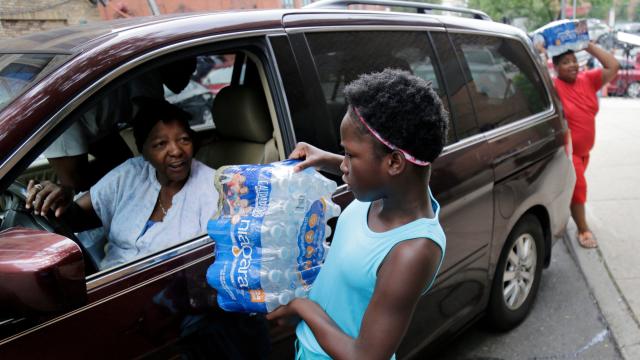When Al Moussab had his water tested for lead, he got comparatively good news. Tests on the taps in his Newark, New Jersey home revealed lead in concentrations of around 6 parts per billion (ppb).
That’s below the U.S. Environmental Protection Agency’s (EPA) “action level” of 15 ppb, but still above the desired level of zero. That’s just one test, though.
Moussab, a high school teacher and chair of Newark Education Workers Caucus, worried the levels could be higher, particularly since the city average in late 2018 was around 48 ppb about. With two young kids and concerns about lead’s impact on their health and development, he turned to buying five-gallon containers of bottled water instead of using the tap.
It turns out Moussab’s caution may have been warranted. Earlier this week, the city began handing out free bottled water to most of its 280,000 residents after the EPA sent a letter to the city noting it was “essential” to advise residents of risks their taps posed and the “responsibility of the City of Newark to provide such bottled water as soon as possible.” It’s the latest twist in three-year saga of Newark’s worsen lead crisis.
The city’s sudden move to offer bottled water to residents followed testing at two households that had been outfitted with city-provided filters. Those filters should have kept lead from drinking water, but the test found elevated lead levels in the filtered water. Moussab told Gizmodo it’s likely because residents weren’t given sufficient instructions on how to install or use the filters, which screw onto a basic sink.
“Our concern was there was very little outreach [by the city],” he said. “You had to go pick it up at the center. They might’ve showed you quickly. For the average person, it’s a complicated issue. We’ve seen people not put filters on correctly. We’ve seen people’s filters expire.”
The filter fiasco has led to a bottled water fiasco. And it’s part of a long-running issue that dates back to 2016, when the city saw a spike in lead-tinged water, which it has failed to get control of. That’s why NEW Caucus in conjunction with Natural Resources Defence Council sued the city in June 2018 to fix the issue.
The groups are going to court later this week to seek to get all residents access to filters and bottled water. Currently, only residents getting water from the Pequannock treatment plant are eligible to receive bottled water from the city. That excludes a number of neighbourhoods in the eastern portion of the city that get water from a different treatment plant, though testing has revealed elevated lead levels there, too.
While it’s tempting to compare Newark to Flint, the poster child for water crises in the U.S., it’s not the most apt comparison. Erik Olson, a senior director at NRDC’s Health and Food Program, told Gizmodo that while Flint was a case of a state-imposed executive taking the town off Detroit’s drinking water in favour of using the polluted Flint River, the Newark situation is different.
“There was a very clear racial overtones to that,” he said. “In Newark, I don’t think that case can be made, though obviously there are still a lot of issues with the predominant African American community suffering from a lack of investment and disinvestment and shrunken size of the city.”
In fact, the crises we’ve seen in Newark and Flint are just the most extreme examples of a burgeoning water crisis in the U.S., an issue that’s the top environmental concern for Americans. Olson said that he wrote a report back in 2003 on 20 major U.S. cities struggling with elevated lead levels in their drinking water. But the problem has persisted for decades, and Flint in his words “blew everything up.” In the wake of the revelations about Flint’s polluted water, the EPA pushed states to more aggressively monitor lead.
“Things started showing up that may have been there for a while, but it became clear in many communities across the country that the lead problem had not gone away and may have got worse,” Olson said.
In Newark, the city has offered to address the tainted water crisis in the long-term by replacing service lines with lead in them. The issue is that the offer requires residents to pay $US1,000 ($1,482), something that Moussab said many low-income residents won’t be able to afford. Landlords who don’t have to live with the risks of lead-infused water also might not want to pony up the money.
“What does that mean? You’re stuck with the dangers of lead for the rest of the time you live in the house?” Moussab said.
The solution also won’t address all the dead-end lines, which Olson said are an issue in a city that’s seen its population shrink by nearly 40 per cent since 1960. That will allow water to sit around and corrode pipes, leaching lead from the water system’s phantom limbs. All this points to the fact that residents like Moussab and the lawyers are NRDC are likely going to have dig in for a protracted battle with the city to get things right, and the fight could provide some lessons along the way.
“As history teacher, I can teach students about history and what people have done,” Moussab said. “By going out and doing it, those are much stronger lessons. We believe when we fight with the working class, our lives improve.”
